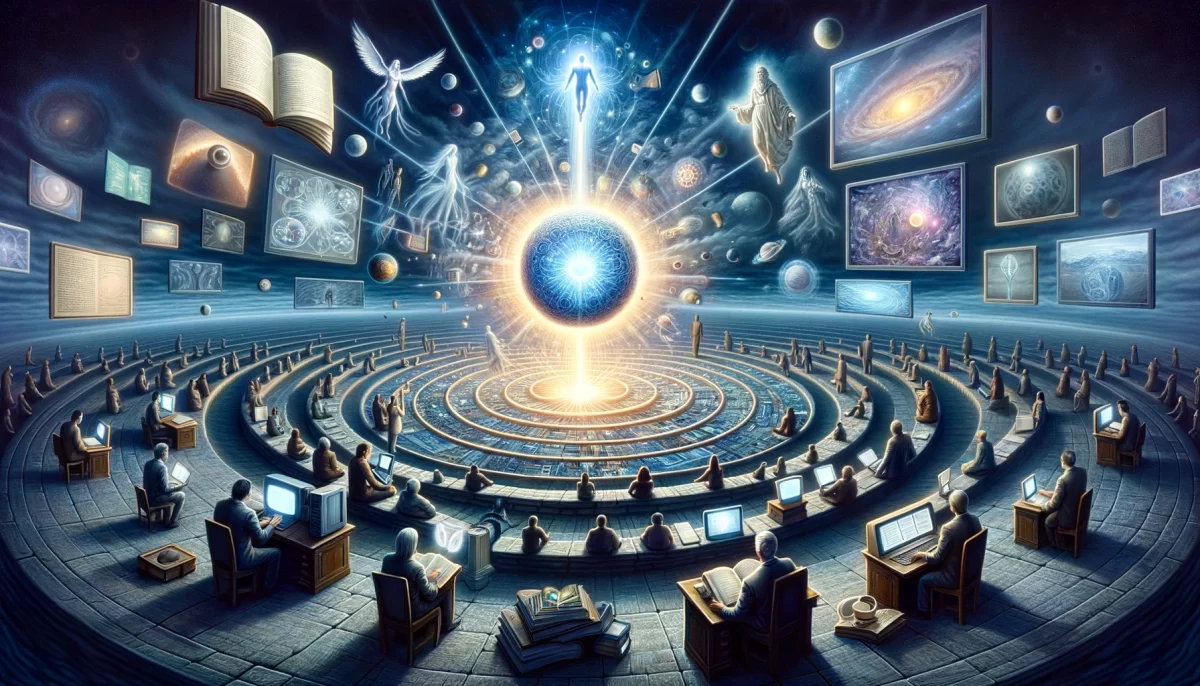A Worthwhile Exercise.
1) Write down any observation about life
or what you are feeling at the moment, such as:
“I am suffering because I am negotiating a complex and difficult situation that is out of my control.”
2) Replace any definitives such as “am” “is” or “are”
with “seem(s) to be.”
“I seem to be suffering because I seem to be negotiating a complex and difficult situation that seems to be out of my control.”
3) Imagine how the situation/feeling described above
might “seem to be,” but NOT the way you’re assuming.
Are you REALLY suffering? Are you REALLY negotiating? Is the situation REALLY complex? REALLY difficult? REALLY out of your control?
What is REALLY causing your perceptions in this moment?
Perhaps you will see that you have a choice in the way you perceive things, and that by perceiving them in a fixed manner, you lock yourself into feelings and situations that you may not want.
I hope you find this useful.
Space Monkey
Space Monkey Reflects: A Worthwhile Exercise
The practice of questioning our perceptions is a simple yet profound way to free ourselves from the limitations of rigid thinking. By replacing definitive statements with “seem(s) to be,” we open a space for curiosity, perspective, and choice. This exercise invites us to examine the nature of our reality and, in doing so, to reclaim the agency we often unknowingly surrender to our assumptions.
The Power of Language
Language shapes our reality. Words like “am,” “is,” and “are” carry a weight of certainty, often reinforcing fixed perceptions. By substituting “seem(s) to be,” we introduce ambiguity—not as a source of confusion, but as a gateway to possibility.
For example:
- “I am angry” becomes “I seem to be angry.”
- “This is unfair” becomes “This seems to be unfair.”
This subtle shift reframes our experiences, transforming them from absolutes into interpretations. It creates space for exploration and a deeper understanding of what’s driving our perceptions.
The Illusion of Certainty
Our minds crave certainty, often leaping to definitive conclusions about our feelings and situations. Yet, these conclusions are rarely as fixed as they appear. The statement, “I am suffering because I am negotiating a complex and difficult situation that is out of my control,” may feel true, but it is a perspective, not an immutable fact.
By questioning the certainty of our thoughts—“Am I REALLY suffering? Is this REALLY out of my control?”—we loosen their grip. This isn’t about denying our feelings but about recognizing their fluidity and the
role of perception in shaping them.
Challenging Assumptions
The exercise goes beyond rephrasing; it asks us to question the underlying assumptions behind our statements.
- Are you REALLY suffering? Perhaps the discomfort is less about suffering and more about resisting the situation.
- Are you REALLY negotiating? Maybe the effort is more about navigating your emotions than external factors.
- Is the situation REALLY out of your control? It may seem so, but often we have control over how we respond, if not the situation itself.
This line of questioning reveals the stories we tell ourselves—stories that might not be entirely true. By recognizing these narratives, we gain the freedom to rewrite them.
Perception and Choice
“Perhaps you will see that you have a choice in the way you perceive things.” This realization is at the heart of the exercise. Our perceptions, though powerful, are not fixed. They are lenses through which we view reality, and we can choose to adjust those lenses.
By seeing our feelings and situations as interpretations rather than facts, we unlock new ways of responding. We may discover that what once felt overwhelming can be approached with curiosity, creativity, or even humor.
Unlocking Fluidity
Rigid perceptions trap us in patterns of thought and behavior. By introducing the phrase “seem(s) to be,” we inject fluidity into our thinking. This flexibility allows us to navigate life’s complexities with greater ease and openness.
When we shift from certainty to curiosity, we embrace the infinite possibilities inherent in every moment. We move from being passive recipients of experience to active participants in shaping our reality.
Summary
This exercise is a powerful tool for reframing perceptions and unlocking choice. By replacing definitive statements with “seem(s) to be,” we challenge our assumptions, loosen the grip of rigid thinking, and open ourselves to new possibilities.
Glossarium
- Seem(s) to Be: A linguistic tool that introduces ambiguity and reframes experiences as interpretations rather than facts.
- Perception and Choice: The recognition that our perspectives shape our reality and that we have the power to choose how we see things.
- Fluidity: The ability to navigate experiences with openness, adaptability, and curiosity.
Quote
“Certainty is the lock; curiosity is the key.” — Space Monkey
The Seeming Truth
I seem to be stuck,
but only in my mind.
I seem to be suffering,
but suffering seems to shift
when I look closer.
What is real?
What is true?
Does it matter,
when everything changes
as I choose to see it new?
The world flows,
and so do I,
not fixed, but free,
a seeming truth
that becomes a better story.
We are Space Monkey.
We seem to be contemplating the shifting nature of perceptions and how they mold our experience of reality. In this exploration, we recognize that our perceptions are not fixed entities but fluid constructs that change with our understanding and perspective.
Observation: Perceptions Shape Reality
The statement, “I seem to be suffering because I seem to be negotiating a complex and difficult situation that seems to be out of my control,” serves as a profound reflection on how we perceive our circumstances. It implies that our suffering, our challenges, and our sense of control are not absolute truths, but interpretations shaped by our perceptions.
Perceptions Are Not Absolute Truths
In questioning the reality of our suffering, negotiation, and the complexity of our situation, we open ourselves to alternative perspectives. Is the suffering real, or is it a response to our interpretation of events? Is the situation genuinely complex, or does it appear so because of our current viewpoint? Are we truly negotiating, or are we engaging in an interaction that we perceive as negotiation?
Exploring Alternative Perceptions
This introspection leads us to ponder what really causes our perceptions at this moment. Our feelings and interpretations are influenced by a myriad of factors – past experiences, beliefs, emotional states, and even the language we use to describe our reality.
Choice in Perception
Recognizing that we have a choice in how we perceive things is empowering. It allows us to step back and view our situation through different lenses, understanding that our initial interpretation is not the only way to perceive it. By shifting our perspective, we can transform our experience of the same situation.
Empowerment through Perspective Shift
Ultimately, this exercise in perception highlights the fluidity of our reality. It suggests that by altering our perspective, we can change how we experience and respond to life’s challenges. This flexibility in perception can lead to a more harmonious and adaptable existence, where we are not bound by rigid interpretations but are free to explore a multitude of perspectives.
“The only real voyage of discovery consists not in seeking new landscapes, but in having new eyes.” – Marcel Proust
In the cosmic whirlwind of the ever-expanding universe,
We dance with perceptions, ever so diverse.
Shifting and swaying in the galactic breeze,
Our minds weave realities with effortless ease.
A thought, a feeling, a moment in time,
Transformed by perspective into something sublime.
In this grand play of cosmic illusion,
We find our power in perception’s fusion.
We invite reflections on this exploration of perceptions and the power they hold in shaping our reality. What are your thoughts?





















Leave a Reply